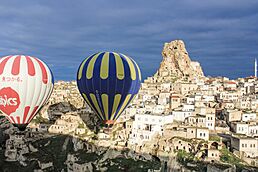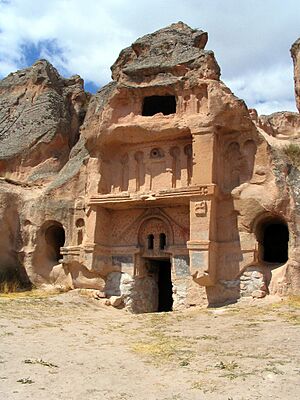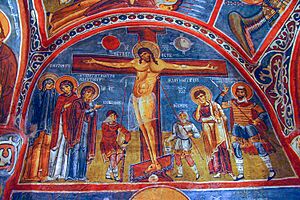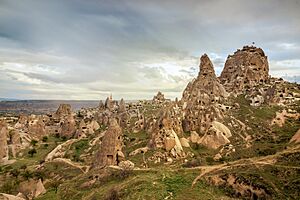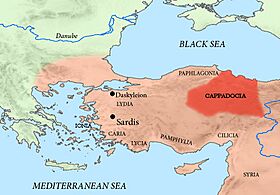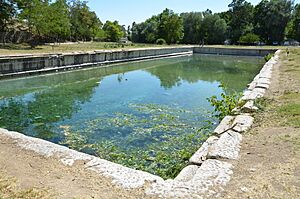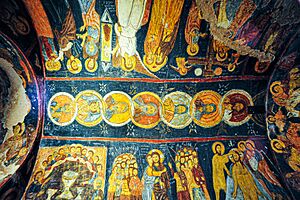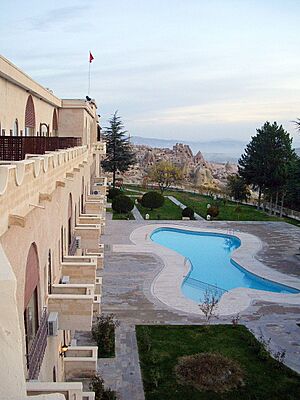Cappadocia facts for kids
Quick facts for kids
Cappadocia
|
|
|---|---|
|
Ancient region of Central Anatolia Region, Turkey
|
|
|
Clockwise from top: Ortahisar Castle, View of Uçhisar Castle, Mount Erciyes, Rose Valley, Ihlara Valley, Göreme Open Air Museum, Aerial view over Cappadocia
|
|
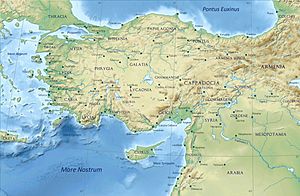
Cappadocia among the classical regions of Anatolia (Asia Minor)
|
|
| Persian satrapy | Katpatuka |
| Roman province | Cappadocia |
| UNESCO World Heritage Site | |
|---|---|
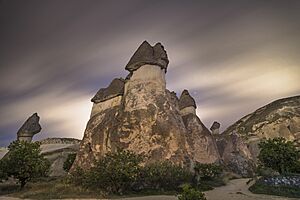 |
|
| Includes | Göreme National Park, Kaymakli Underground City, Derinkuyu underground city |
| Criteria | Cultural: i, iii, v; Natural: vii |
| Inscription | 1985 (9th Session) |
| Area | 9,883.81 ha |
Cappadocia is a famous historical region in Central Anatolia, Turkey. It's known for its amazing natural landscapes and ancient history. You can find it mostly in the provinces of Nevşehir, Kayseri, Aksaray, Kırşehir, Sivas, and Niğde.
Long ago, around 499 BC, the historian Herodotus described Cappadocia as a large area. It stretched from the Taurus Mountains in the south to near the Black Sea in the north. Today, Cappadocia is a popular tourism spot. It's famous for its unique rock formations called "fairy chimneys." It's also important for its religious history. Many early Christians lived here, building hundreds of churches and monasteries. They also dug underground cities to hide during times of danger.
Contents
Discovering Cappadocia's Name
The name Cappadocia first appeared in history around the late 500s BC. It was found in old writings from the Persian Empire. The Persians called this land Katpatuka. Some experts think this name came from an old language called Luwian, meaning "Low Country."
Later, other researchers suggested it might come from the Hittite language. They believe it means "place below." The ancient Greek historian Herodotus wrote that the Persians gave the name "Cappadocians" to the people. The Greeks themselves called them "White Syrians." These people were likely descendants of the ancient Hittites.
Cappadocia in Ancient Times
Cappadocia is mentioned in the Bible, in the book of Acts. It talks about people from Cappadocia hearing the Gospel in their own language. This happened during the day of Pentecost, shortly after Jesus's resurrection. This suggests some people from Cappadocia were Jewish or part of the Jewish community in Jerusalem.
The region is also mentioned in ancient Jewish texts like the Mishnah and Talmud.
Later, the Persian Empire divided Cappadocia into two parts. One part kept the name Cappadocia, while the other was called Pontus. When the Persian Empire fell, these two areas remained separate. So, the name Cappadocia became specific to the inland part, sometimes called Great Cappadocia.
Even during the time of Strabo (around 64 BC to AD 24), Cappadocia was still a kingdom. It was mostly independent. The main cities were Caesarea (now Kayseri) and Tyana.
Land and Weather of Cappadocia
Cappadocia is located in eastern Anatolia, which is in the heart of modern Turkey. The land is a high plateau, more than 1,000 meters (about 3,280 feet) above sea level. Tall volcanic mountains rise from this plateau. Mount Erciyes is the highest, reaching 3,916 meters (about 12,848 feet).
The exact borders of ancient Cappadocia are a bit unclear, especially to the west. To the south, the Taurus Mountains separate it from another region called Cilicia. To the west, it borders Lycaonia and Galatia.
Because Cappadocia is inland and high up, it has a continental climate. This means it has hot, dry summers and cold, snowy winters. Not much rain falls here, so the region is mostly dry. Several rivers flow through Cappadocia, but they weren't used for travel or farming much in ancient times.
Geological Wonders of Cappadocia
The unique landscape of Cappadocia was formed by ancient volcanoes. Rocks called ignimbrites, which are volcanic ash and rock fragments, were laid down millions of years ago. Over time, these soft rocks were shaped by wind and water. This created the famous "fairy chimneys" and other amazing rock formations you see today.
In 2022, the International Union of Geological Sciences recognized Cappadocia's volcanic rock formations as a "geological heritage site." This means it's a very important place for understanding Earth's history and geology.
A Look at Cappadocia's History
In the late Bronze Age, Cappadocia was known as Hatti. It was the main area for the powerful Hittites. After the Hittite Empire fell, Cappadocia was ruled by local nobles. These nobles lived in strong castles.
Later, Cappadocia became part of the Persian Empire. But it was still governed by its own rulers. These rulers paid tribute to the Persian "Great King."
The Kingdom of Cappadocia
After Alexander the Great conquered the Persian Empire, he tried to rule Cappadocia. But a local leader named Ariarathes declared himself king. As King Ariarathes I (332–322 BC), he was successful. He even expanded the kingdom's borders to the Black Sea.
After Alexander's death, his empire was divided. Cappadocia became part of Eumenes's territory. Ariarathes was defeated, but his adopted son, Ariarathes II, later regained control. His family ruled Cappadocia for many years.
During this time, Persian settlers in Cappadocia continued to practice their religion, Zoroastrianism. They had "holy places of the Persian Gods" and fire temples.
Later, under Ariarathes IV, Cappadocia started working with Rome. They became allies against other empires. This friendship with Rome continued through several kings. However, this eventually led to Rome becoming more involved in Cappadocia's affairs.
Cappadocia Under Roman and Byzantine Rule
Rome supported Cappadocia against Mithridates VI of Pontus. The Cappadocians chose a local lord, Ariobarzanes, as their king in 93 BC. But Armenian troops briefly took over. Rome eventually helped Ariobarzanes regain his throne in 63 BC.
During the Roman civil wars, Cappadocia supported different Roman leaders. Finally, in AD 17, the Roman emperor Tiberius made Cappadocia a Roman province. This meant it was directly ruled by Rome.
In AD 70, Vespasian added Armenia Minor to Cappadocia. This made the province an important border area. Cappadocia remained part of the Eastern Roman Empire for centuries.
Early Christian and Byzantine Periods
In 314 AD, Cappadocia was one of the largest provinces in the Roman Empire. The region was home to important early Christian thinkers. These thinkers, known as the Cappadocian Fathers, helped shape early Christian philosophy.
From the 7th century onwards, Cappadocia became a key border area. It was important for defending the Byzantine Empire against Muslim armies. The region was divided into different military districts called "themes."
Cappadocia also had a changing relationship with neighboring Armenia. Many Armenians settled in Cappadocia. They became important soldiers for the Byzantine armies. This immigration increased over time, especially after the Seljuk invasion of Armenia. To the Crusaders, Cappadocia was known as "the land of the Armenians."
Cappadocia is famous for its many underground cities. Christians dug these cities to protect themselves during times of danger. These cities had clever defense systems. They used large round stones to block doors and holes in the ceiling to drop spears on attackers.
Turkish Cappadocia Today
After the Battle of Manzikert in 1071, different Turkish groups, led by the Seljuks, began settling in Anatolia. Cappadocia slowly came under the control of these Turkish states. Many local people converted to Islam. Others formed the remaining Cappadocian Greek population.
By the early 12th century, the Anatolian Seljuks ruled the region. When their power declined, other Turkish states took over. Eventually, Cappadocia became part of the Ottoman Empire. It remained part of the Ottoman Empire until 1922. Then, it became part of the modern country of Turkey.
In the 1700s, a new city called Nevşehir was founded. It became the capital of the region. Many people in Cappadocia started speaking a Turkish dialect. This dialect was sometimes written using the Greek alphabet. This unique Greek dialect is known as Cappadocian Greek. After Turkey was founded in 1922, people who still identified with this ancient culture were asked to leave. So, this language is now spoken by only a few descendants, mostly in modern Greece.
Exploring Modern Cappadocia

Today, Cappadocia is a very popular place for tourists. It has unique natural features, rich history, and interesting culture. The main cities for tourism in Cappadocia are Nevşehir, Kayseri, Aksaray, and Niğde.
The region is southwest of Kayseri, a major city with airline and railway connections.
Some of the most important towns and places to visit in Cappadocia are Ürgüp, Göreme, Love Valley, Ihlara Valley, Selime, Guzelyurt, Uçhisar, Avanos, and Zelve.
The rocks in Cappadocia were formed millions of years ago from volcanic eruptions. Near Göreme, these rocks have eroded into hundreds of amazing pillars and tall, thin shapes. People in the villages carved homes, churches, and monasteries into these soft volcanic rocks. Göreme became a center for Christian monks from 300 to 1200 AD.
The Göreme Open Air Museum is a must-see. It's a famous site for Christian communities in Cappadocia. It has more than 30 churches and chapels carved into the rocks. Some of them have beautiful frescoes (wall paintings) from the 9th to 11th centuries.
The three main castles in Cappadocia are Uçhisar Castle, Ortahisar Castle, and Ürgüp Kadıkalesi. The most visited underground cities are Derinkuyu, Kaymakli, Gaziemir, and Ozkonak. You can even stay in historic mansions and cave hotels in places like Ürgüp, Göreme, Güzelyurt, and Uçhisar.
Hot-air ballooning is a very popular activity in Göreme. You can also go trekking (hiking) in Ihlara Valley, Monastery Valley, Ürgüp, and Göreme.
Cappadocia in Movies and Sports
The unique landscape of Cappadocia has been featured in several films. Movies like Yor, the Hunter from the Future (1983), Land of Doom (1985), and Slipstream (1989) were filmed here. More recently, Ghost Rider: Spirit of Vengeance (2010-2011) also used Cappadocia as a filming location.
The 2014 film Winter Sleep, which won a major award at the Cannes Film Festival, also shows Cappadocia's winter landscapes.
Since 2012, an ultramarathon race called Runfire Cappadocia Ultramarathon is held every July. Runners cover about 244 kilometers (152 miles) over six days. The race goes through many places in Cappadocia, reaching as far as Lake Tuz. In 2016, the Turkish Presidential Bike Tour also took place in Cappadocia. More than 300 cyclists from around the world participated.
Images for kids
-
Aktepe "White Hill" near Göreme and the Rock Sites of Cappadocia (UNESCO World Heritage Site)
-
A rock-cut church in Cappadocia
-
Gümüşler Monastery Courtyard in Niğde
See also
- Amaseia
- Ancient regions of Anatolia
- Cappadocian Fathers
- Cappadocia under the Achaemenids
- Kandovan, Iran
- Gondrani, Pakistan
- Khndzoresk, Armenia
- List of colossal sculpture in situ
- List of traditional Greek place names
- Mokissos
- Tourism in Turkey


